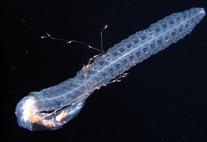Abstract
Re-descriptions are given for all the known species in the siphonophore physonect genera Halistemma (Family Agalmatidae) and Stephanomia (Family Stephanomiidae fam. nov.) based almost entirely on specimens collected by submersibles or ROVs. A new Halistemma species, H. maculatum sp. nov., is also described. Until now two of the Halistemma species were known only from incomplete specimens, such that for one, H. cupulifera Lens & van Riemsdijk, only the tentilla had been described, while for the other, H. striata Totton, only the nectophores were known. The species Stephanomia amphytridis Lesueur & Petit, originally established on the basis of only an illustration of part of the siphosome, is poorly known and several descriptions in the past have been based on further siphosomal material that actually belonged to a species of Halistemma. A specimen of that species, which included the nectosome, was recently described by Mapstone (2004) as H. amphytridis, but Pugh (2006) considered that it actually belonged to H. foliacea Quoy & Gaimard. That specimen has been re-examined for this study. The taxonomic position of the two genera is discussed. Although only distantly related the species of the two genera have a post-larval form referred to as the Nectalia stage. Haeckel (1888b) originally described a specimen at this stage as a separate species, Nectalia loligo. Nectalia stage specimens of two Halistemma species and of S. amphytridis were present in the material and their relationship with Haeckel's specimen is discussed.

